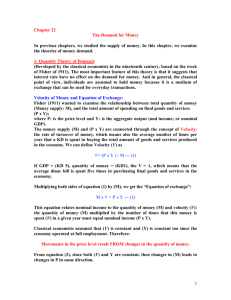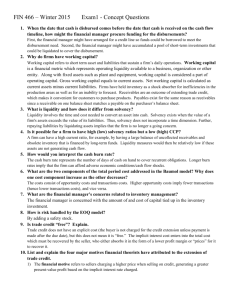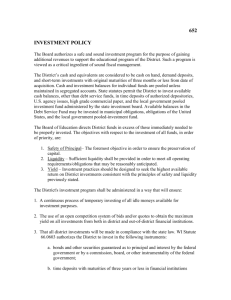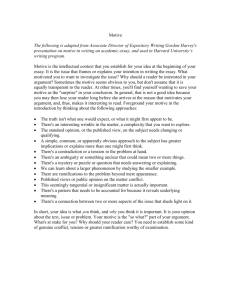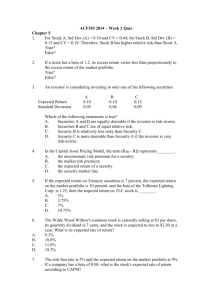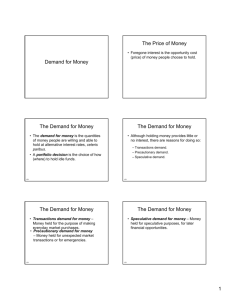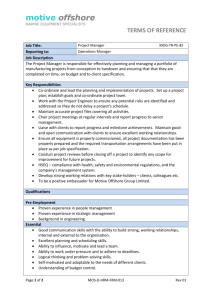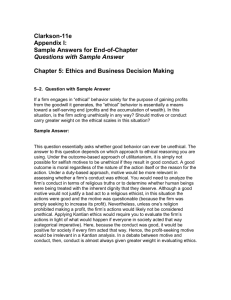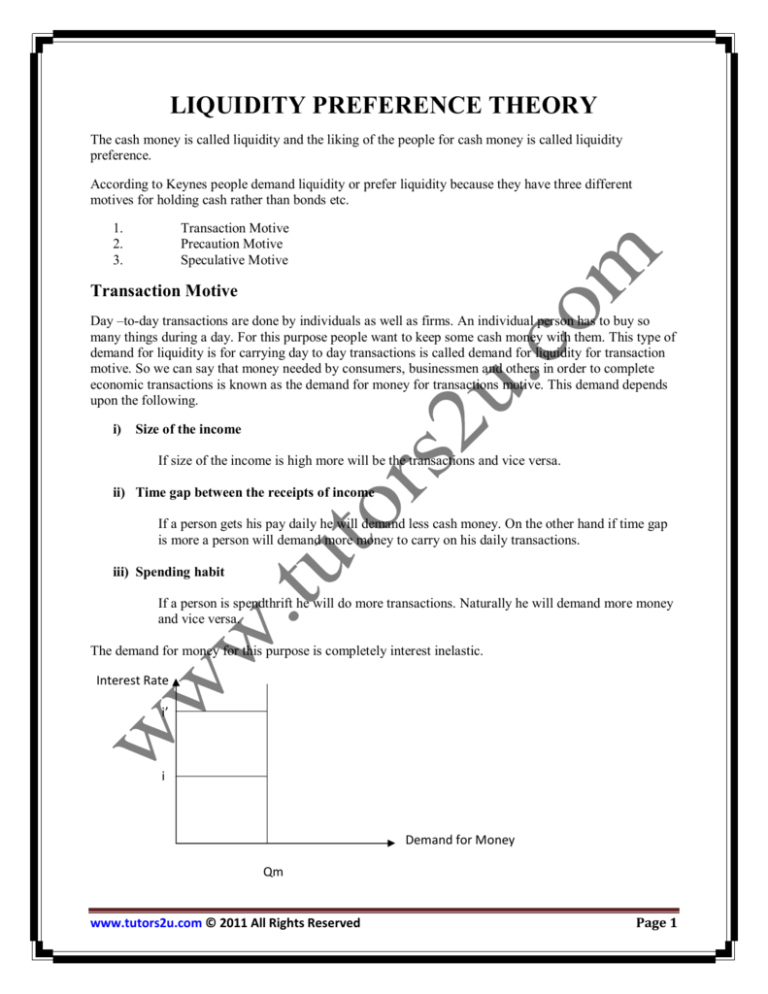
LIQUIDITY PREFERENCE THEORY
The cash money is called liquidity and the liking of the people for cash money is called liquidity
preference.
According to Keynes people demand liquidity or prefer liquidity because they have three different
motives for holding cash rather than bonds etc.
1.
2.
3.
Transaction Motive
Precaution Motive
Speculative Motive
Transaction Motive
Day –to-day transactions are done by individuals as well as firms. An individual person has to buy so
many things during a day. For this purpose people want to keep some cash money with them. This type of
demand for liquidity is for carrying day to day transactions is called demand for liquidity for transaction
motive. So we can say that money needed by consumers, businessmen and others in order to complete
economic transactions is known as the demand for money for transactions motive. This demand depends
upon the following.
i)
Size of the income
If size of the income is high more will be the transactions and vice versa.
ii) Time gap between the receipts of income
If a person gets his pay daily he will demand less cash money. On the other hand if time gap
is more a person will demand more money to carry on his daily transactions.
iii) Spending habit
If a person is spendthrift he will do more transactions. Naturally he will demand more money
and vice versa.
The demand for money for this purpose is completely interest inelastic.
Interest Rate
i’
i
Demand for Money
Qm
www.tutors2u.com © 2011 All Rights Reserved
Page 1
PRECAUTIONARY MOTIVE
Every man wants to save something or wants to keep some liquid money with him to meet some
unforeseen emergencies, contingencies and accidents. Similarly business firms also want to keep some
cash money with them to safeguard their future. This type of demand for liquidity is called demand for
precautionary motive. This demand depends upon many factors.
i)
Size of the income
If the size of the income of a person or a firm is large, he will demand more money for
safeguarding his future.
ii)
Nature of the person
Some persons are optimistic while others are pessimistic .The former think always about the
bright side of future. So they anticipates less, if any risk and danger in the future. Naturally
such persons will demand less money for precautionary motive. On the contrary ,
pessimistic persons or firms foresee many dangers, calamities and emergencies in the
future. In order to meet these, they want to have more cash with them.
iii)
Farsightedness
A farsighted person can see better about the future. He will make a proper guess of the
future. Thus if he expects more emergencies, he will keep more money with him in cash
and vice versa.
T he demand for money for precautionary motive is also completely interest inelastic.
Interest Rate
i’
i
Demand for Money
Qm
www.tutors2u.com © 2011 All Rights Reserved
Page 2
SPECULATIVE MOTIVE
People want to keep cash with them to take advantage of the changes in the prices of bonds and
securities. In advanced countries, people like to hold cash for the purchase of bonds and securities when
they think it profitable. If the prices of the bonds and securities are expected to rise speculators will like
to purchase them. In this situation they will not like to keep cash with them. On the other hand if prices
of the bonds and securities are expected to fall people will like to keep cash with them. They will buy the
bonds and securities with the cash only when their prices would fall .So liquidity preference will be more
at lower interest rates.
Interest Rate
Demand for Money
THE LIQUIDITIY PREFERENCE CURVE
The transactions balances and precautionary balances are held with the intention of being used to make
purchases as and when required, they are sometimes jointly referred as demand for active balances.
The important point about the demand for active balances is that it is not responsive to changes in the
rate of interest i.e . it is interest inelastic. T he demand for speculative balances, on the other hand is
sometimes referred to as the demand for idle balances.
We can have the community’s total demand for money or liquidity preference schedule by adding the
demand for active (La) and idle balances (Li ) together.
i
i
La
i
Li
Qm
www.tutors2u.com © 2011 All Rights Reserved
LP (La + Li )
Qm
Qm
Page 3
SUPPLY OF MONEY
The supply of money is quite different from the demand for money. No private individual can change it.
Supply of money is controlled by the central bank or its government. Money supply depends upon the
currency issued by the government and the policies of the central bank regarding with credit creation. In
the short run at a particular period of time supply of money remains constant. That’s why the supply
curve money is perfectly inelastic.
Rate of Interest
Ms
Supply of Money
What determines the interest rate?
The interaction of demand and supply of money determines the interest rate.
Rate of interest
Ms
i
LP
Qm
In the above diagram LP is the demand for money and the Ms is the supply of money. This gives an
equilibrium rate of interest i . At any rate of interest above i , the supply of money exceeds demand and
this will pull down the rate of interest, while at any rate of interest below i the demand for money
exceed supply and this will bid up the rate of interest. Once the rate of interest is established at i , it will
remain at this level until there is a change in the demand for money and or the supply of money. This
implies that the authorities have two choices
www.tutors2u.com © 2011 All Rights Reserved
Page 4
They can fix the supply of money and allow interest rates to be determined by the demand for
money; or
They can fix the rate of interest and adjust the supply of money to whatever level is appropriate
so as to maintain the rate of interest.
The liquidity trap
LP
Rate of interest
Ms
Ms1
i
Qm
Qm
Qm1
It is the situation in which changes in money supply have no influence on the rate of interest, monetary
policy cannot be used to influence other variables such as consumption and investment when the rate
of interest is i.
www.tutors2u.com © 2011 All Rights Reserved
Page 5


